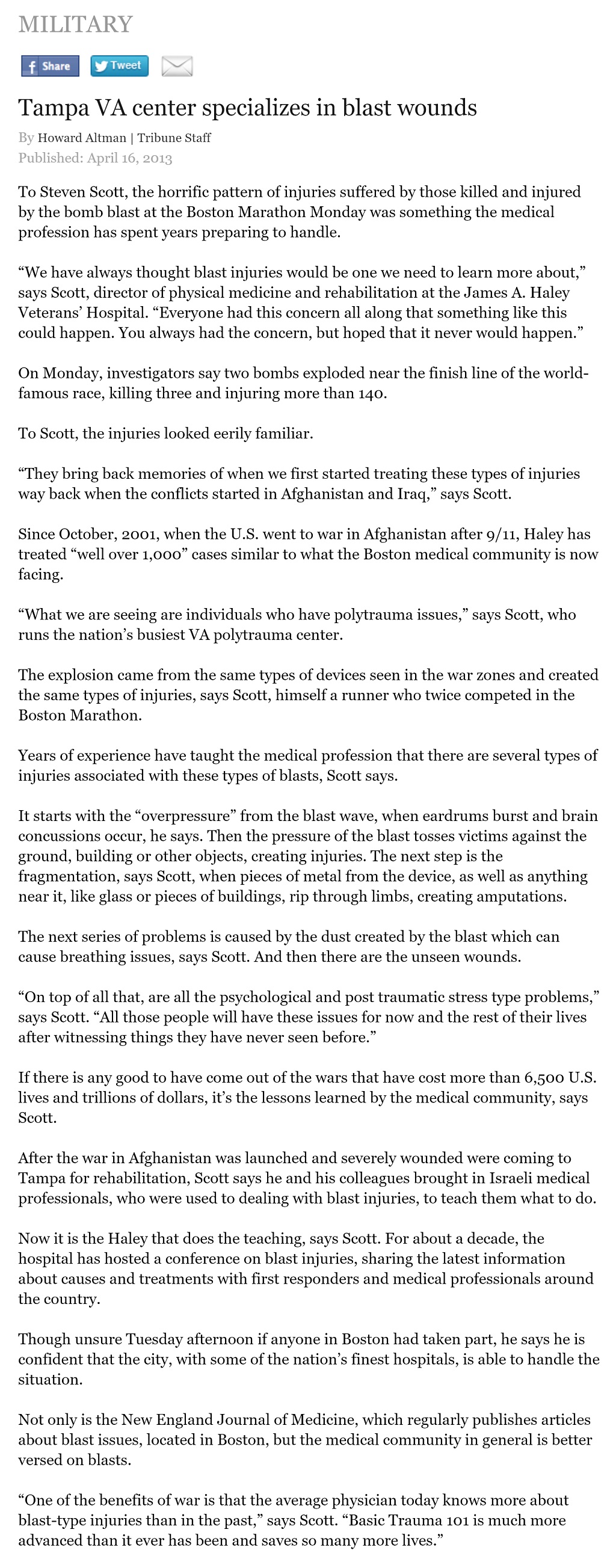
To Steven Scott, the horrific pattern of injuries suffered by those killed and injured by the bomb blast at the Boston Marathon Monday was something the medical profession has spent years preparing to handle.
“We have always thought blast injuries would be one we need to learn more about,” says Scott, director of physical medicine and rehabilitation at the James A. Haley Veterans’ Hospital. “Everyone had this concern all along that something like this could happen. You always had the concern, but hoped that it never would happen.”
On Monday, investigators say two bombs exploded near the finish line of the world-famous race, killing three and injuring more than 140.
To Scott, the injuries looked eerily familiar.
“They bring back memories of when we first started treating these types of injuries way back when the conflicts started in Afghanistan and Iraq,” says Scott.
Since October, 2001, when the U.S. went to war in Afghanistan after 9/11, Haley has treated “well over 1,000” cases similar to what the Boston medical community is now facing.
“What we are seeing are individuals who have polytrauma issues,” says Scott, who runs the nation’s busiest VA polytrauma center.
The explosion came from the same types of devices seen in the war zones and created the same types of injuries, says Scott, himself a runner who twice competed in the Boston Marathon.
Years of experience have taught the medical profession that there are several types of injuries associated with these types of blasts, Scott says.
It starts with the “overpressure” from the blast wave, when eardrums burst and brain concussions occur, he says. Then the pressure of the blast tosses victims against the ground, building or other objects, creating injuries. The next step is the fragmentation, says Scott, when pieces of metal from the device, as well as anything near it, like glass or pieces of buildings, rip through limbs, creating amputations.
The next series of problems is caused by the dust created by the blast which can cause breathing issues, says Scott. And then there are the unseen wounds.
“On top of all that, are all the psychological and post traumatic stress type problems,” says Scott. “All those people will have these issues for now and the rest of their lives after witnessing things they have never seen before.”
If there is any good to have come out of the wars that have cost more than 6,500 U.S. lives and trillions of dollars, it’s the lessons learned by the medical community, says Scott.
After the war in Afghanistan was launched and severely wounded were coming to Tampa for rehabilitation, Scott says he and his colleagues brought in Israeli medical professionals, who were used to dealing with blast injuries, to teach them what to do.
Now it is the Haley that does the teaching, says Scott. For about a decade, the hospital has hosted a conference on blast injuries, sharing the latest information about causes and treatments with first responders and medical professionals around the country.
Though unsure Tuesday afternoon if anyone in Boston had taken part, he says he is confident that the city, with some of the nation’s finest hospitals, is able to handle the situation.
Not only is the New England Journal of Medicine, which regularly publishes articles about blast issues, located in Boston, but the medical community in general is better versed on blasts.
“One of the benefits of war is that the average physician today knows more about blast-type injuries than in the past,” says Scott. “Basic Trauma 101 is much more advanced than it ever has been and saves so many more lives.”
